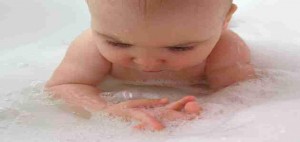The first thing to remember about bathing a baby is that it is not necessary. If at first the idea worries you, give him a partial bath and wait until you feel confident about “proper’’ bathing. The next important point is to make sure you have all the necessary equipment on hand before you pick up the baby (see checklist in the margin of this page). All the descriptions given here are for a right-handed person. If you are left-handed, read left for right and vice versa.

Partial bath.
This is clone by sitting the baby dressed on your knee, his head resting on your left arm. Take absorbent cotton, wrung out in cool water, and wipe it gently over his face.
If his eyes are all sticky use two more pieces of absorbent cotton, moistened in the same way — one for each eye — and wipe gently away from the nose. This avoids the possibility of any cross-infection.
Never use soap on your baby’s face.
If the baby has any dried secretions in his nose, wipe them away with absorbent cottons gently pressing below the nostril to dislodge them. There is no need to dig into a baby’s nostrils, for even absorbent cotton, which seems soft to an adult. Can scratch the delicate membranes inside the nose.
When you have finished, pat the child’s face dry with a soft towel. (By the time the baby is about six to eight weeks old, you can use a soft. sponge for washing his face.) Now take off his lower clothes and diaper.
Then place a towel under our baby’s buttocks and. holding up his feet with your left hands wash his bottom with the other. Use soapy absorbent cotton.
Sponge off the soap, pat dry and rub powder carefully into the creases. Many mothers like to give a partial bath, and to do all diaper changing, on a special mat.
Others prefer to sit down and use their laps.
Towel bath
One way to bathe a baby without actually immersing him is to give him a towel bath. Undress the baby and lay him on a towel. On your lap or on a changing mat. Wash his face as described earlier. Then wash his body. Especially in the armpit creases and arm and neck folds. Wash his bottom, paying particular attention to the groin creases and the one between the buttocks. Lightly sponge his legs and arms and pat him dry by cuddling him in the towel.
Bathing
The temperature of the bathroom should be around 75—80°F (24—27°C) and the water 95—97°F (35- 36°C). It is wise to put cold water into the bath first, both to avoid putting the baby in water which is too hot and because the tub itself may retain the heat of the hot water. So the baby could possibly burn himself on it.
Test the temperature of the bath water with a thermometer or more conveniently, with your own elbow. If you can’t decide whether your elbow feels hot or cold the temperature is correct.
Undress your baby, wrap him in a towel and wash his face. Then unwrap him and cradle him in your arms with his head — the heaviest.
